Guest post by Barbara A. Smith.
Hippotherapy is a specialized treatment area used by occupational therapists, physical therapists, and speech and language pathologists. It involves utilizing the sensory-motor aspects of horses to achieve therapeutic goals such as improving sensory processing to tolerate touch and motor plan sequential movements. Although the horse functions as a therapy tool, it is obviously much more exciting than a swing or therapy ball, offering opportunities to develop an emotional bond, communication and social skills.
Let’s look at the basics of hippotherapy
Although the healing power of horses has been recognized for thousands of years (Hippocrates mentions it in ancient Greek writings), hippotherapy only developed in Europe in the 1960s and soon after in the United states as an adjunct to physical therapy. Therapeutic goals might have included improving the rider’s strength, postural control, balance and coordination. Hippotherapy’s versatility as a treatment tool gradually expanded as SLPs used it to improve communication skills. Occupational therapists recognized the power of sensory stimulation in promoting engagement and functional hand skills, such as manipulating fasteners. For example, this rider enjoys opening the zipper on my glasses case and then handing me the sun glasses. She loves to help out and make both the horse and me happy!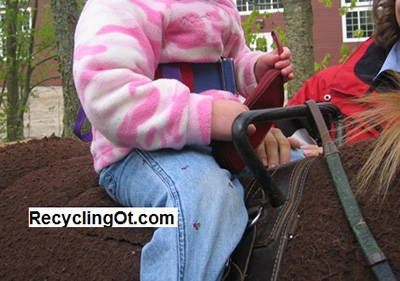
Hippotherapy is a type of Animal Assisted Therapy
Please note that “therapeutic riding” (TR) is a different type of animal assisted therapy (AAT) that is offered by certified therapeutic riding instructors who teach riding skills to people with disabilities. A TR instructor may or may not be an OT, PT or SLP. However, hippotherapy is ONLY performed by a licensed OT, PT or SLP practitioner. Training and certification requirements vary at facilities and many require that the therapist have certification in both TR and hippotherapy. As an OT, my goal is not to teach my client how to ride a horse, although frequently that is the result and many children transition from hippotherapy to do TR and eventually earn medals at the Special Olympics.
Why are horses special therapeutic friends?
Well, many animals are special in their ability to connect with people nonverbally and provide unconditional love. Cats and dogs also provide great heavy pressure and tactile sensory stimulation as they lie on laps and cuddle. However, a child with cerebral palsy may improve range of motion by straddling a horse and the repetitive, smooth vestibular movement can gradually reduce muscle tone. A horse’s gait is similar to the human gait in terms of timing. Clients who have never walked or have an abnormal gait can kinesthetically experience what normal pelvic movement feels like.
I have primarily worked with very young children who received services through their early intervention programs. Many had developmental disabilities, including Down syndrome and autism spectrum disorders. My goals often focused on decreasing sensory defensiveness while increasing engagement, postural control and hand skills. Of course, this involves using a variety of reaching, grasping and manipulation hand activities.
Hippotherapy Provides controlled and graded Sensory Simulation
Simply being on a horse provides sensory stimulation. Actually, as soon as a client enters the hippotherapy facility, they are impacted by happy sounds, smells and scenery. Bouncing on the horse while walking and bouncing even more when trotting provides heavy duty proprioceptive and vestibular sensory input. I control and grade the sensory input with choices such as whether to:
- walk slow, fast and for how long before stopping
- walk in straight, curved lines or in circles
- walk uphill, downhill or only on flat surfaces
- the child faces forward, sideways, and backwards or rides in a different position such as in quadruped or kneeling.
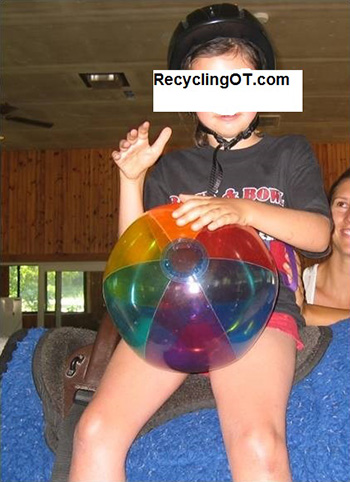 Using Sensory-Based Materials
Using Sensory-Based Materials
- Hipppotherapy horses are selected for many specific attributes including tolerance for riders who may hit, kick or scream. I also use a variety of sensory materials that must first be introduced when there is no rider so that the horse becomes desensitized to materials such as:
- rings tossed onto Color My Class Game Cones
- rings placed on top of a vibrating ring stack (see photo)
- toys and Sound Puzzles that make funny sounds or vibrate
- bubbles like Bubble Bear or No-Spill Bubble Tumbler
- clothespins clipped onto or removed from the mane (this does not hurt the horse)
- ball play, playing catch with toys like Gertie Balls
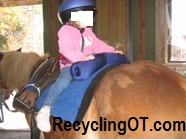 The little girl in the photo is facing backwards while her hands bear weight on top of a vibrating cushion like a Senseez Vibrating Pillow. This helps to decrease her tactile defensiveness before asking her to engage in more complex fine motor tasks.
The little girl in the photo is facing backwards while her hands bear weight on top of a vibrating cushion like a Senseez Vibrating Pillow. This helps to decrease her tactile defensiveness before asking her to engage in more complex fine motor tasks.
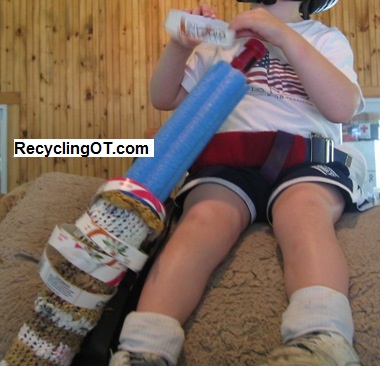 This vibrating ring stack is made by inserting a motorized pen, like a Squiggle Wiggle Writer Pen inside a swimming noodle.
This vibrating ring stack is made by inserting a motorized pen, like a Squiggle Wiggle Writer Pen inside a swimming noodle.
Adapting activities to vibrate is one of the many sensory strategies described in my book From Flapping to Function: A Parent’s Guide to Autism and Hand Skills.
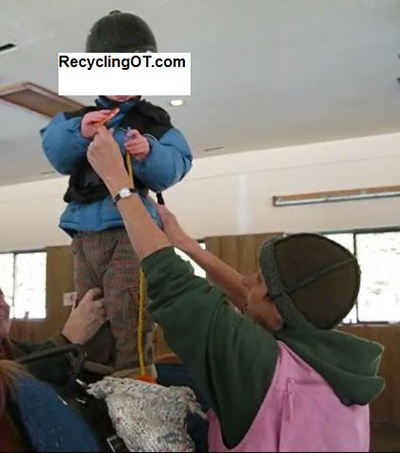
Hand Activities to Develop Postural Control
Clients may work on postural control while reach to touch body parts on the horse or therapist. I like to offer sensory materials to pull or squeeze such as Panic Pete (AKA Martian Popping Thing) while the client maintains a quadruped or kneeling position. The child in the photo squats to take rings out of the bag and stands up while stringing them. He typically has difficulty visually attending but it is difficult NOT to focus and be in the moment when standing on top of a large animal!
 The girl in the photo reaches for rings positioned in front of her before rotating her body to place them over a ring stack. This “ring stack” is actually a cat toy and the mouse on top of a spring squeaks when moved. The sensory aspects of this activity help her to visually attend while developing postural control.
The girl in the photo reaches for rings positioned in front of her before rotating her body to place them over a ring stack. This “ring stack” is actually a cat toy and the mouse on top of a spring squeaks when moved. The sensory aspects of this activity help her to visually attend while developing postural control.
Hand Activities that Develop Cognitive and Manipulation Skills
In my book – From Rattles to Writing: A Parent’s Guide to Hand Skills I describe many simple adaptations that make it easier for children with and without disabilities to develop manipulation skills. For example, lacing boards can be cut out of cardboard and made to have just a few, big holes and thick cord that are easier than string to control.
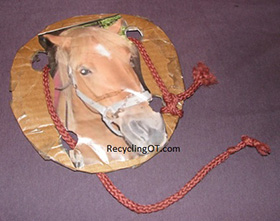 During a typical Hippotherapy session, I spend time walking and trotting, followed by stopping to complete a simple hand activity such as this lacing board. When finished I encourage the child to say or sign “go” to continue movement. Most children are eager to resume movement.
During a typical Hippotherapy session, I spend time walking and trotting, followed by stopping to complete a simple hand activity such as this lacing board. When finished I encourage the child to say or sign “go” to continue movement. Most children are eager to resume movement.
 A horse’s rear end is wide and functions as a convenient work surface. I adapted this puzzle by attaching the pieces with Velcro to the box cover. I encourage the child to use one hand to stabilize the box lid while pulling them off. Of course, this activity also teaches children to identify animals and imitate sounds. The Pizza Party is another activity that would be fun to use in this position.
A horse’s rear end is wide and functions as a convenient work surface. I adapted this puzzle by attaching the pieces with Velcro to the box cover. I encourage the child to use one hand to stabilize the box lid while pulling them off. Of course, this activity also teaches children to identify animals and imitate sounds. The Pizza Party is another activity that would be fun to use in this position.
Creating Functional Hand Skills Objectives
 It’s a good idea to create OT objectives to improve functional skills such as opening and closing buttons because:
It’s a good idea to create OT objectives to improve functional skills such as opening and closing buttons because:
- occupational therapy is all about increasing independence
- this skill is measurable
- insurance companies prefer work on functional, achievable daily living skills rather than abstract goals such as improving coordination
Therefore, I provide activities such as:
- opening and closing extra large fasteners
- opening bags and other containers (like my sunglasses case)
- putting the helmet and gait belt on and off
- unbuckling and putting away the reins, neck strap or other equipment
Video Time!
Video: Sensory Pull Activity for Children with Autism or Sensory Processing Disorders
The first video shows how I made and use the “Sensory Pull Toy” (that I designed) during Hippotherapy to develop:
- reaching, balance and postural control
- hand strength
- visual attention
- eye-hand coordination
- color identification
 This toy is made out of detergent bottles and a strip of fabric. It’s simple to use – the child pulls the handle while in various positions. It can also be used during non horse activities to work on many skills. Please check out my book The Recycling Occupational Therapist for many other easy to make therapeutic activities. You can also try Stretchy String as another sensory toy.
This toy is made out of detergent bottles and a strip of fabric. It’s simple to use – the child pulls the handle while in various positions. It can also be used during non horse activities to work on many skills. Please check out my book The Recycling Occupational Therapist for many other easy to make therapeutic activities. You can also try Stretchy String as another sensory toy.
Video: Hippotherapy with Children with Autism or Sensory Processing Disorders
The second video shows a few of the exciting ways therapists can use hippotherapy to develop hand skills. It is truly amazing how motivated children are to focus and engage in challenging hand activities because they love being cowboys and cowgirls!
 Barbara A. Smith has worked with children and adults with developmental disabilities for over 40 years! She is the author of the Recycling Occupational Therapist, From Rattles to Writing: A Parent’s Guide to Hand Skills and From Flapping to Function: A Parent’s Guide to Autism and Hand Skills. Learn more about her work at RecyclingOT.com.
Barbara A. Smith has worked with children and adults with developmental disabilities for over 40 years! She is the author of the Recycling Occupational Therapist, From Rattles to Writing: A Parent’s Guide to Hand Skills and From Flapping to Function: A Parent’s Guide to Autism and Hand Skills. Learn more about her work at RecyclingOT.com.
